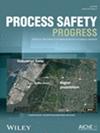方形软锂离子电池热失控特性及风险研究 钉子的穿透力
IF 1
4区 工程技术
Q4 ENGINEERING, CHEMICAL
引用次数: 0
摘要
对 16 Ah/5 Ah 锂离子电池(LIB)及其模块的钉穿透热失控(TR)特性进行全面调查。该研究旨在分析爆裂特性,并检查特定条件下 TR 行为的变化,目的是改进对锂离子电池 TR 事故的早期预警和保护。研究结果表明,机械钉穿透可迅速触发 TR,导致最高温度在 51.9 秒内达到 522.3°C,最快为 20 秒。值得注意的是,当电池鼓起时,会释放出高温两相热流,并伴有大量可燃气体排出。这种升级增加了进一步爆炸的风险。此外,研究还观察到反复喷射的火焰和大量烟雾的产生。此外,研究还强调了温度突然升高和 H2 释放作为 TR 早期指标的作用。这些发现为方形软质锂电池的特性和风险提供了宝贵的理论见解,加强了安全措施,并有助于开发锂电池的早期预警系统。本文章由计算机程序翻译,如有差异,请以英文原文为准。
Research on the thermal runaway characteristics and risks of square soft lithium‐ion batteries nail penetration
To conduct a comprehensive investigation into the nail penetration thermal runaway (TR) characteristics of 16 Ah/5 Ah lithium‐ion batteries (LIBs) and their modules. The study aims to analyze the burst characteristics and examine the variations in TR behavior under specific conditions, with the goal of improving early warning and protection against LIB TR incidents. The research findings demonstrate that mechanical nail penetration can rapidly trigger TR, resulting in the highest temperature 522.3°C within 51.9 s, and the fastest is 20 s. In the case of LIB modules, a secondary temperature rise occurs, exhibiting an increased rate of up to 77%. Notably, when the battery bulges, there is a release of high‐temperature two‐phase heat flow accompanied by a significant discharge of combustible gases. This escalation increases the risk of further explosions. Moreover, the study observes repeated spray fires and the generation of a considerable amount of smoke. Additionally, the study highlights the role of sudden rise in temperature and the release of H2 as early indicators of TR. These findings provide valuable theoretical insights into the characteristics and risks of square soft LIBs, enhance safety measures, and contribute to the development of early warning systems for LIBs.
求助全文
通过发布文献求助,成功后即可免费获取论文全文。
去求助
来源期刊

Process Safety Progress
工程技术-工程:化工
CiteScore
2.20
自引率
10.00%
发文量
99
审稿时长
6-12 weeks
期刊介绍:
Process Safety Progress covers process safety for engineering professionals. It addresses such topics as incident investigations/case histories, hazardous chemicals management, hazardous leaks prevention, risk assessment, process hazards evaluation, industrial hygiene, fire and explosion analysis, preventive maintenance, vapor cloud dispersion, and regulatory compliance, training, education, and other areas in process safety and loss prevention, including emerging concerns like plant and/or process security. Papers from the annual Loss Prevention Symposium and other AIChE safety conferences are automatically considered for publication, but unsolicited papers, particularly those addressing process safety issues in emerging technologies and industries are encouraged and evaluated equally.
 求助内容:
求助内容: 应助结果提醒方式:
应助结果提醒方式:


